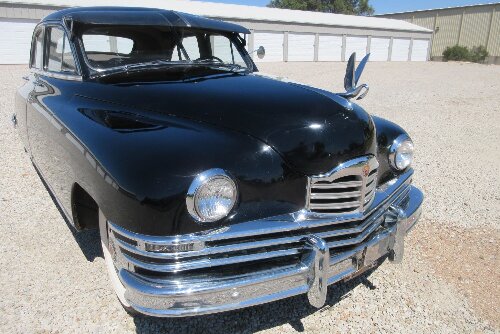|
Re: replacement radiator?
|
||||
|---|---|---|---|---|
|
Home away from home

|
Jim. That's EXCELLENT critical analysis.
On my 56 V8 Exec. I tried and electric fan WITH a 6 blade aftermarket fan on the water pump. I found that the electric fan in front of the condensor served little or no effect. In real hot weather of 100+ degrees i believe it only restricted air flow. At idle it showed no improvement. I think it only created a restriction. THE PROBLEM is that he condensor sets about 1.5 inches FORWARD of the radiator due to the horse collar diagonal brace. Look at most cars with AC and the condensor is nearly up against the radiator. I shrouded the condensor to the radiator and noticed some improvement worth the effort. I have not yet come up wit h a good engine fan shroud arrangement despite repeated tries with various plastic modern shrouds but didn't really delve into the fitting like i should. Problem with the V8 is that the engine fan sets excessively to the right of the radiator. I'm glad u brought up the engine fan shroud idea. I'll try to get busy on a fit for the V8's. Back in the late 50's and 60's before the plastic revolution i saw at least 3 cars built with fan shrouds made from zinc wash tubs. I don't remeber how they atached mounting bracket tho. I'd rather use plastic shrouds that are commonly available because it is lite.
Posted on: 2008/7/13 13:00
|
|||
|
||||
|
Re: replacement radiator?
|
||||
|---|---|---|---|---|
|
Home away from home

|
Go to the junkyards and look at old Fords, Chevys, Dodges, etc. I remember several of those vehicles having a simple two piece steel shroud that would be easy to adapt to almost anything. You'll be looking for '50s and early 60's cars.
I have one like this: 1963 Impala fan shroud But it's in two pieces. As long as the diameter's right, you can make the mounts any way you like.
Posted on: 2008/7/13 14:11
|
|||
|
||||
|
Re: replacement radiator?
|
||||
|---|---|---|---|---|
|
Home away from home

|
On the subject of electric fans, I have to say this: On my '49 Hudson pickup I built, I used a 429 Ford with C6 combo to power it. I also used an aluminum radiator and fan assembly from a '97 Dodge Caravan mini van that originally had a 3.0L V6 or the like. It NEVER overheated, not even once. The secret? It was a modern, dual fan arrangement with a built in shroud. I set it up so that the slow speed fan came on when it hit 160 degrees, then the second fan came on when it reached 190 degrees. Simple thing to do, as you can look at the temp ratings of temperature senders and switches in most parts books, especially Standard, Wells, and a few others. Run them through a relay, and you're done. This little radiator wasn't more than 1" thick, and approx. 34" wide and 18" tall, if I remember correctly. It never overheated even on 100+ degree days and with the notorious Kansas 100% humidity.
And it would burn rubber like no tomorrow!!: <a href="http://vids.myspace.com/index.cfm?fuseaction=vids.individual&videoid=7591740">1949 Hudson Pickup</a><br/><object width="425px" height="360px" ><param name="allowFullScreen" value="true"/><param name="movie" value="http://mediaservices.myspace.com/services/media/embed.aspx/m=7591740,t=1,mt=video"/><embed src="http://mediaservices.myspace.com/services/media/embed.aspx/m=7591740,t=1,mt=video" width="425" height="360" allowFullScreen="true" type="application/x-shockwave-flash" /></object>
Posted on: 2008/7/13 14:21
|
|||
|
||||








